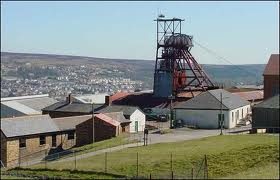
Big Pit celebrates 30 years as a major tourist attraction
1 Big Pit in Blaenavon in South Wales may have been open to the public since 1983, but the colliery was sunk to its current level in 1880 and subsequently closed as a mine 100 years later, on February 2, 1980. So the old site’s looking pretty good for its age.
2 Who doesn’t like something for nothing? In 2001, Big Pit became incorporated into the National Museums and Galleries of Wales. As well as becoming known as Big Pit: National Coal Museum of Wales, it’s totally free to visit. So now you have no excuse if you haven’t already been.
3 What’s in a name? The name Big Pit – or Pwll Mawr – came from the size of its elliptical shaft which, at 5.5m by 4.6m, was the first in the area wide enough to wind two trams of coal side by side. Who says size doesn’t matter?
4 And it really was a big pit – an earlier mine, Kearsley Pit, was sunk to a depth of 39m in 1860, but for Big Pit, it was deepened to 89m. Although the main colliery is more than 130 years old, its underground workings incorporate much earlier shafts and tunnels – like Forge Level, which was driven in 1812 to supply iron and coal for Blaenavon Ironworks.
5 With a work rate that can only dazzle, shortly after opening the colliery was producing more than 100,000 tonnes of coal from an area of about 12 square miles.
 6 It’s a mine that spreads over a vast area – the original site saw nine different coal seams being worked at various stages, with its first class ‘steam coal’ making South Wales became famous around the world.
6 It’s a mine that spreads over a vast area – the original site saw nine different coal seams being worked at various stages, with its first class ‘steam coal’ making South Wales became famous around the world.
7 There’s lots to be seen here, and don’t we known it – as well as the many thousands of miners who staffed it when it was a working mine, people are still beating a path to the pit, with visitor numbers in the 30 years since its reopening as the National Coal Museum of Wales have so far exceeded more than more than 3.5 million visitors, around 155,000 per year.
8 Nowadays you can follow in the footsteps of those original workers, as a grand day out at the pit includes galleries and audio-visual presentations, but the highlight of the visit is the hour-long underground tour, led by ex-miners, which takes you down in the pit cage to walk through underground roadways, air doors, stables and engine houses built by generations of mineworkers.
9 Although it took the sinking of the colliery in the 1880s to make it a business concern, there is evidence that coal mining has been taking place in the Blaenavon area at least since Roman times, when pieces of coal were picked from the outcrops on the hillsides. Talk about making the most of what nature has to offer.
10 It’s all about knowing what you’re looking for – Big Pit stands on the eastern rim of the South Wales Coalfield, where coal outcrops, iron ore and limestone were found, making it a natural solution for an ironworks to be founded at Blaenavon.
11 A magnificent sight in our own backyard – the nearby Blaenavon Ironworks were established in 1789 by three men from the West Midlands and the remains are now open for visitors, with Blaenavon being declared a World Heritage Site.
12 The ironworks were the first purpose-built multi-furnace works in Wales. The cost of construction was paltry by today’s standards – £40,000 – and also resulted in the creation of the town of Blaenavon which previously did not exist.

13 Population explosions like this don’t happen anymore – workers flooded into the area causing the population of Monmouthshire to grow faster than that of any other county in Britain at the time, doubling between 1800 and 1810.
14 With that expansion, by 1796, the ironworks were the second largest in Wales (after Cyfarthfa in Merthyr Tydfil), producing 5,400 tonnes of iron a year. Its success saw piece of Wales travelling far and wide with iron from Blaenavon taken by packhorse, tramroad, canal and, from 1852, by railway to Newport Docks, from where it was exported all over the world, being used to build railways across India, America and Australia.
15 In the beginning, colliers cut the coal by hand – talk about a hard day’s work! Much-needed mechanisation did not come to Big Pit until 1908 when a mechanical conveyor was finally installed.
16 As a mining community, it’s had its share of tragedies. The parish records of Blaenavon contain the names of many local men, women and children who were killed in industrial accidents. On December 11, 1908, three men were killed in a localised explosion, while on April 7, 1913, another three men lost their lives in a localised fire.
17 In a spark of genius, the pit was among the first in South Wales to be electrified, and by 1910 the ventilating fan, pumps and underground haulage system were all worked by electricity.
18 It wasn’t all plain sailing from then, though – despite that modernisation, the winding gear continued to be driven by a steam engine until 1953. The first of the post war nationalisation improvements came to Big Pit in the late 1950s in the form of a plough, which was a mechanical cutter and loader pulled along the face by a chain.
19 Keeping up the good work, output of coal peaked in South Wales in 1913 and at its busiest Big Pit employed 1,300 men. In 1980, when the mine closed, the workforce had been reduced to just 250.
20 Although the colliery was flying high with early 20th century successes, there came a slump in the 20s and 30s when there was 57% unemployment in Blaenavon. World War II offered a brief respite, but by 1966 Big Pit was the only deep mine left in the Blaenavon area.
21 Don’t even think about lighting up – Big Pit is still classed as a working colliery and must comply with the Mines and Quarries Act safety legislation just like any other coal mine. As such, it is forbidden to take any smoking materials or incendiary substances underground, including battery-operated watches and photographic equipment as well as cigarettes, matches, lighters.
22 Even though smoking paraphernalia was always banned, that didn’t stop the mine workers. Former miner Brynley Lewis went straight into the colliery in August 1936 at 14 years old and remembers how the men would smoke going down the shaft until they reached the pit bottom. Then they’d take their little boxes of tobacco out and hide them somewhere ready for when they came out after their shift.
23 The end of the holidays might be a shock in this day and age, but imagine getting a week off a year! In the 1930s as a working mine, the August holiday week was the only time the colliery ever shut down, and the mine owners would let the horses up for just seven days when they got to have fresh air and grazing.
24 Keeping it clean got easier through time. Until 1939 miners travelled to work and home again in their working cloths, but in that year the pithead baths were opened. Each miner then had two lockers – one for his clean cloths and one for his working cloths separated by the showers. Nowadays the baths house an exhibition and licensed café.
25 Things you don’t expect down below? The Blaenavon Cheddar Company’s Pwll Mawr cheddar is actually matured at the bottom of the mine shaft at Big Pit and can be bought at the museum gift shop.
26 One of the biggest tourist attractions in the country, it was made even better in 2004 with a relaunch following a £7.2m programme of redevelopment.
27 Thanks to funding from the Heritage Lottery Fund (£5.3m), Welsh Assembly Government, Wales Tourist Board, the Garfield Weston Foundation, the Lloyds TSB Foundation and a number of private trusts and funds, the redevelopment restored much of Big Pit to its original state. Some buildings were returned to their former glory, and some were converted for a new use, to match the needs of a world-class museum for the 21st century.
28 It’s an award-winner, but we don’t like to shout about it – Big Pit won the prestigious Gulbenkian Prize in 2005 for Museum of the Year, beating off stiff competition from nearly 60 other museums across the UK to scoop this major award.
29 It’s all part of a bigger picture of history – in 2000, Blaenavon achieved World Heritage Status as the best preserved example of an industrial town anywhere in the world. All the main elements of a coal and iron town remain: the ironworks, coal mine, steam railway, the workers’ houses, school for the children of workers, church, workmen’s hall, tramroads and links to canals.
30 This talk of going underground is all very well, but if you’re happier staying on the surface, you can explore the colliery buildings like the winding engine-house, the blacksmiths’ workshop and the pithead baths where you can learn more about the story of coal and its extraction from below the ground.












